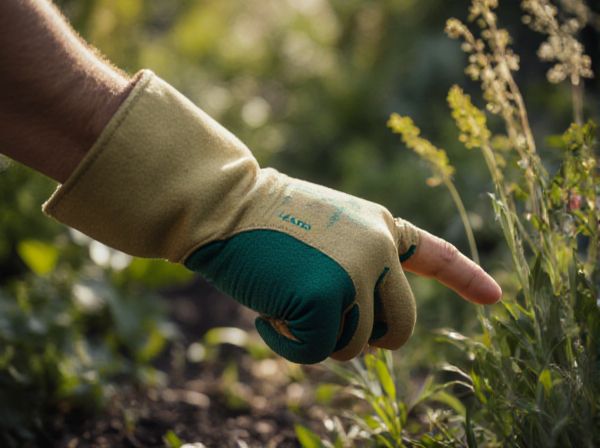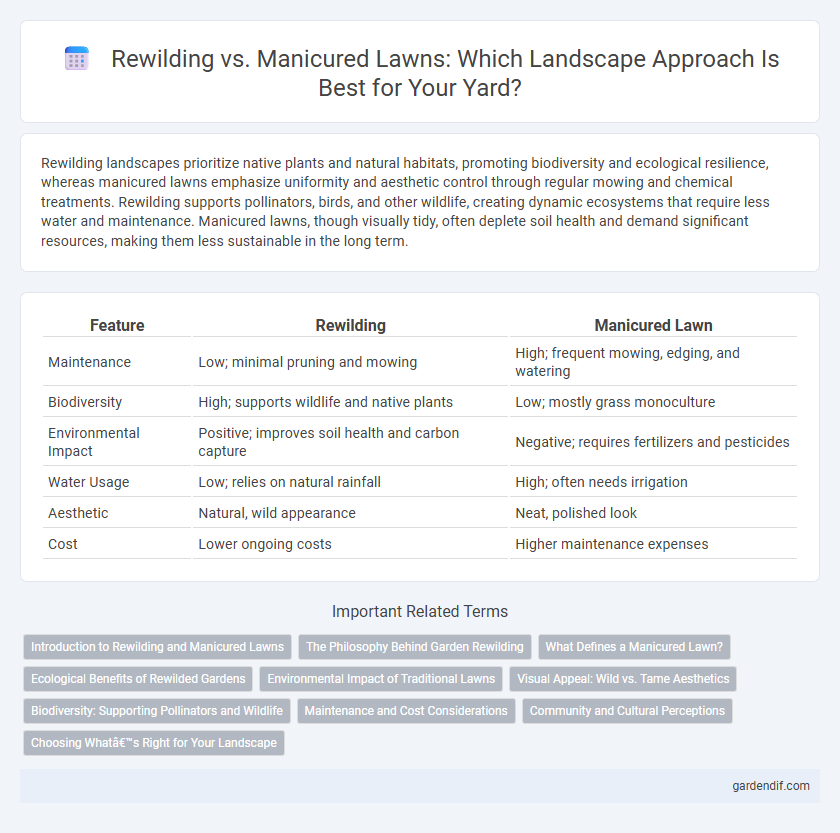
Rewilding vs Manicured Lawn Illustration
Rewilding landscapes prioritize native plants and natural habitats, promoting biodiversity and ecological resilience, whereas manicured lawns emphasize uniformity and aesthetic control through regular mowing and chemical treatments. Rewilding supports pollinators, birds, and other wildlife, creating dynamic ecosystems that require less water and maintenance. Manicured lawns, though visually tidy, often deplete soil health and demand significant resources, making them less sustainable in the long term.
Table of Comparison
| Feature | Rewilding | Manicured Lawn |
|---|---|---|
| Maintenance | Low; minimal pruning and mowing | High; frequent mowing, edging, and watering |
| Biodiversity | High; supports wildlife and native plants | Low; mostly grass monoculture |
| Environmental Impact | Positive; improves soil health and carbon capture | Negative; requires fertilizers and pesticides |
| Water Usage | Low; relies on natural rainfall | High; often needs irrigation |
| Aesthetic | Natural, wild appearance | Neat, polished look |
| Cost | Lower ongoing costs | Higher maintenance expenses |
Introduction to Rewilding and Manicured Lawns
Rewilding involves restoring natural ecosystems by encouraging native plant growth and promoting biodiversity, creating habitats that support local wildlife. In contrast, manicured lawns emphasize uniform, closely cut grass, often requiring extensive maintenance and chemical use to achieve a pristine appearance. Understanding the ecological benefits of rewilding versus the aesthetic focus of manicured lawns highlights the trade-offs between environmental sustainability and traditional landscaping practices.
The Philosophy Behind Garden Rewilding
Garden rewilding embraces natural ecosystems by prioritizing biodiversity over uniformity, allowing native plants and wildlife to flourish with minimal human intervention. This philosophy contrasts sharply with the manicured lawn approach, which emphasizes symmetry, regular maintenance, and aesthetic control, often at the expense of ecological health. Rewilding fosters resilience and sustainable habitats, promoting soil vitality, pollinator support, and natural pest control within private and public landscapes.
What Defines a Manicured Lawn?
A manicured lawn is defined by its uniform, closely trimmed grass, often maintained through regular mowing, edging, and the use of fertilizers and herbicides to achieve a pristine and controlled appearance. It emphasizes symmetry, smooth texture, and minimal variation in plant species, promoting an orderly and aesthetically pleasing landscape. This traditional approach to lawn care contrasts sharply with rewilding, which encourages biodiversity and natural growth patterns.
Ecological Benefits of Rewilded Gardens
Rewilded gardens significantly enhance local biodiversity by providing habitats for pollinators, birds, and native flora, which are often scarce in manicured lawns. These naturalized spaces improve soil health and water retention through diverse plant root systems, reducing erosion and the need for artificial irrigation. By fostering ecological balance, rewilded gardens support carbon sequestration and promote resilience against climate change impacts compared to traditional lawn maintenance.
Environmental Impact of Traditional Lawns
Traditional lawns require extensive water usage, chemical fertilizers, and pesticides, contributing to soil degradation and water pollution. These manicured landscapes support limited biodiversity, often displacing native plants and wildlife. Rewilding promotes ecological restoration by fostering native species, enhancing soil health, and reducing carbon footprints.
Visual Appeal: Wild vs. Tame Aesthetics
Rewilding landscapes showcase a diverse palette of native plants, creating dynamic textures and colors that shift with the seasons, offering an organic and natural visual appeal. Manicured lawns present a uniform, tightly controlled green surface that conveys order and tidiness, appealing to those who prefer symmetry and predictability in outdoor spaces. The contrast between wild aesthetics and tame lawns reflects differing priorities in biodiversity promotion versus traditional landscape design.
Biodiversity: Supporting Pollinators and Wildlife
Rewilding promotes biodiversity by providing diverse habitats that support pollinators and wildlife, offering flowering plants and native grasses essential for bees, butterflies, and birds. Manicured lawns typically consist of monocultures that limit food sources and shelter, reducing insect populations and overall ecosystem health. Increasing native plantings and reducing lawn chemical use enhance habitat connectivity and resilience for local species.
Maintenance and Cost Considerations
Rewilding landscapes typically require lower maintenance costs compared to manicured lawns due to reduced mowing, watering, and fertilizing needs. While manicured lawns demand regular upkeep with specialized equipment and labor, rewilded areas promote biodiversity and soil health with minimal intervention. Cost savings in rewilding stem from decreased water usage, fewer chemical inputs, and less frequent maintenance schedules.
Community and Cultural Perceptions
Rewilding landscapes fosters biodiversity and reflects a community's growing commitment to environmental stewardship, contrasting sharply with the aesthetic uniformity prized in manicured lawns. Cultural perceptions often favor manicured lawns as symbols of order and social status, while rewilded spaces challenge traditional norms by embracing natural growth and seasonal change. This shift in landscape preference highlights evolving values toward sustainability and a deeper connection with local ecosystems within communities.
Choosing What’s Right for Your Landscape
Selecting between rewilding and a manicured lawn depends on your landscape's ecological goals, maintenance capacity, and aesthetic preferences. Rewilding promotes biodiversity, supports native species, and enhances soil health by allowing natural growth, while manicured lawns offer a controlled, uniform appearance but require regular mowing, watering, and chemical treatments. Evaluating factors such as local climate, soil conditions, and desired wildlife habitat can guide you in choosing the most sustainable and visually appealing option for your outdoor space.
Rewilding vs Manicured Lawn Infographic

 gardendif.com
gardendif.com